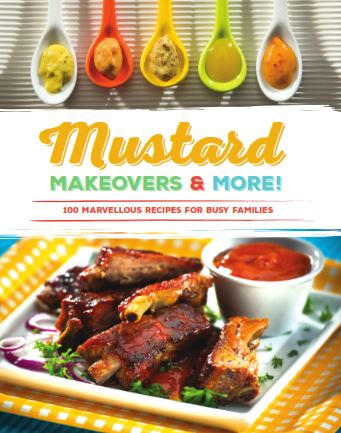This blog post was written by one of my awesome nutrition student volunteers - Sara Reece. Her mustard recipe making adventure will be sure to inspire you to turn the ordinary into extraordinary next time you step into the kitchen. ~Jodi Robinson, RD (Owner, Craving Health)
I am a fan of cookbooks that take simple, fresh and low cost household ingredients and turn them into delicious dishes, with the help of select pantry staples. Mustard is one such staple. At 3 calories, zero fat and trace amounts of sugar per 1 tsp serving, prepared traditional yellow mustard can fit any calorie budget.[i] The Mustard Make Over and More book produced by the Saskatchewan Mustard Farmers exemplifies my preferred cookbook style by offering everything you would ever want to know about mustard, including types and their respective uses, proper storage, and home preparation; you’ll be a mustard whiz in no time! The book is invaluable for spicing up dishes that have become mundane and familiar like bean salad, potato salad or turkey burgers. Here are my top 5 inspired tips from constructing my chosen mustard recipes:
1. Don’t be afraid to experiment in the kitchen
I wasn’t always a mustard enthusiast. However, after making a few of the recipes in The Mustard Makeovers and More recipe book I realize that mustard can be far more than just something to occasionally mix into egg salad or as a condiment atop sandwiches or hot dogs. This book incorporates various mustard varieties into sliders, meatloaf, stews, salads, and even desserts! I constructed a few of the recipes with my grandmother, who was so impressed she hauled out her ancient recipe cards and added the potato salad. Keep in mind, my grandmother didn’t even have yellow mustard in her fridge before we started this mustard dinner adventure.
2. Any type of salad containing a marinade/dressing gets better with time
With the exception of your traditional lettuce based salads, potato, bean, and quinoa salad are considerably more flavourful after sitting overnight. Think leftovers that get progressively tastier and allow you to have healthful, homemade meals to enjoy throughout the week. From a nutrition standpoint you could consider draining some of the additional dressing after the salad has sat or when you purchase store bought salads packed in vinaigrettes. You’ll still get all the flavour while saving excess calories from the fat contained in the oil of the dressing.
3. Fresh herbs beat out the dried varieties for flavour, time and time again
The turkey burgers called for fresh sage and we figured we would see if there was a substantial flavour difference between the dried and fresh variety in the sliders. And there was, BIG time! Consider purchasing the fresh varieties, cleaning and chopping them into recipe sized portions and freezing them, or check out the squeeze bottles made from fresh herbs. If you’re just the occasional user of certain herbs and spices, dried varieties are ideal and the least labour intensive option to still get some flavour. When compared ounce for ounce, dried varieties of herbs tend be more concentred and therefore, are often more antioxidant packed than their fresh counterparts[ii].
4. Consider healthful alternatives to low nutrient ingredients.
The turkey sliders recipe called for oat bran as the binder, which provides a good source of fibre, yet is flavourless and of a similar texture as traditional plain old, nutrient void, white bread crumbs. This is not a licence to reconstruct every recipe but within reason, small modifications and changes can be virtually undetectable and deliver higher nutrition. Other examples include, Greek yogurt for sour cream, broth for butter in savoury dishes (such as mashed potatoes), apple sauce for butter in baking, cottage cheese for cream cheese, or dark green leafy veggies such as kale and arugula for iceburg lettuce.
5. Mustard packs a nutritional punch
Made from simple ingredients including mustard seeds (derived from the mustard plant), vinegar, salt, water, cayenne pepper, and turmeric (to give mustard its notable bright yellow colour)iii, the origins of mustard go as far back as ancient times when it was used by the Greeks and Romans for medicinal purposes.iv To date, several studies have linked mustard seeds to reducing the risk of cancer. How so? Mustard seeds (along with all cruciferous vegetables) contain powerful plant compounds called isothiocyanates (ITCs), which act to ward off invading cancer cells in the body. Moreover, mustard is a source of selenium, an antioxidant that also plays an important role protecting the body against cancer.i
Bottom Line:
Versatile, cost effective, nutritious, and flavourful, mustard provides a tasty zing to any dish! Suspected to aid in the prevention of cancer, mustard keeps well when refrigerated and comes in a wide range of varieties, each with limitless applications in the kitchen. Bon appetite!
About the Author
Sara Reece is an aspiring dietitian, currently completing her BASc in Food and Nutrition at Ryerson University.
References
[i] Canadian Nutrient File (2016). Sauce, Mustard, yellow, ready-to-serve. Retrieved from https://food-nutrition.canada.ca/cnf-fce/report-rapport.do
[ii]Greger, Michael (2012). Antioxidants in a Pinch: Dried Herb and Spices. Retrieved from http://nutritionfacts.org/2012/09/06/spices-antioxidants-in-a-pinch/
iii Verranki, O., Bhattacharya, A. et al (2015). Cruciferous vegetables, isothiocyanates, and prevention of bladder cancer. Curr Pharmacol Rep, Aug;1(4):272-282.
ivThe Origins of Mustard. Les Assaisonnements Briard. Retrieved September 6, 2013 from http://www.moutarde-de-meaux.com/en/histo-origine-moutarde.php





